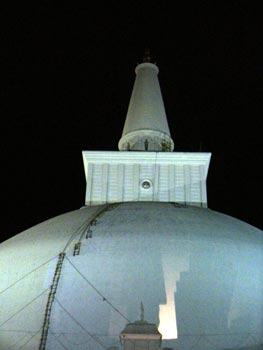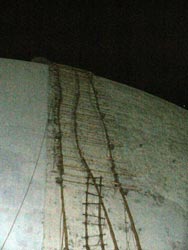
Painters in the sky!Braving the elements and other dangers a group of people keep the dagoba’s shimmering white The beautiful white dagobas of Anuradhapura are wonders of the world, admired by all who see them. However, maintaining the glory of these gigantic structures is no easy task. They need constant care and little known to the public, there is a group of people who risk their lives to keep them shimmering white. Painting a dagoba like Ruwanveliseya is probably one of the most difficult jobs in the world. The painters have to brave the elements- the scorching sun, strong winds that whirl around, the rain and thunder when it comes. One wrong step could end up in tragedy. Courage and determination are their strength, climbing a creaky ladder without any other support amidst the gusty wind.
“Once, our painters were attacked by a colony of wasps that were nesting on Hatharas Kotuwa. Wasps stung the painters, but they managed to climb down safely. If they panicked, it could have ended up in disaster. Another time, a ladder caught in the wind, twisted and a painter fell. But luckily nothing serious happened. We are here for a noble cause and may be the divine powers are protecting us,” Kumarage Sampath who is currently at Ruwanveliseya told The Sunday Times. Sampath is the leader of a group of forty plus workers who toil day in and day out to paint the Ruwanveliseya. His father, Kumarage Akman was involved in painting the Ruwanveliseya for nearly two decades and this is the nineteenth consecutive year that his team is painting this mammoth dagoba. Before starting out, the group participates in a ritualistic puja to Sri Maha Bodhiya. It has become a custom to invoke the blessings and protection of the divine powers to complete their difficult task safely. At 338 feet, the pinnacle of the stupa is over 30 stories high. They start by building scaffolding up to the “Devatha Kotuwa”, the square block that sits on top of the dagoba. There are bricks in the dagoba that have been purposely set for this task. Bamboos are used for the scaffolding, considering their light weight and strength. Once the main scaffolding is in place, another mobile ladder assembled on the ground is sent up into position. To stabilize the ladder against the winds, it is pinned by several other cross ropes tied tight to the ground. These are more than 20 metres long and curve to the shape of the dagoba. Painters then climb the ladder to various levels. The painting is done by hand, by stretching up and as far they can. Then the painter descends a few steps and starts painting the area below. After that stretch is completed, the ladder is moved a little further around the structure. This process is continued until the whole dagoba is painted. “Painting the “Koth kerella and Devatha kotuwa is difficult. We assemble another ladder and send it to the top. Those who paint the last part just climb that ladder while two people hold its base. The person on the top should balance himself against the strong wind on top. It is dangerous. You need to be brave enough to do that,” said Sampath.
Ruwanveliseya gets a lime white-wash annually. Salt, washing blue and various kinds of sago are mixed together to make the paint. The sago is to strengthen the mixture and make it stick to the wall. This was supposedly done even during ancient times. Two coats of paint and nine tons of lime are needed to complete the operation. “Painting the dagoba is indeed a difficult task,” the Ruwanveli Mahaseya's Chief Incumbent Ven. Pallegama Hemarathana Nayaka Sthavira commented. “Ruwanveliseya is the largest dagoba in Sri Lanka which gets a white-wash. Though Abhayagiriya and Jethawanaramaya are bigger, they are open brick structures which don’t need to be whitewashed. Since its ancient glory was restored in 1940, Ruwanveliseya was painted once in two years. But with time, the surface of the dagoba has been softening. It doesn’t retain the paint properly. So since 2000, it is being painted annually. The painters build a temporary ‘wadiya’ for their use and sometimes sleep on the stone floor that has been smoothened by the feet of billions of devotees over centuries. It usually takes about two months to paint a dagoba like Ruwanveliseya and they face many hardships, being away from their families but it is their commitment and effort that brings Ruwanveliseya to its shimmering glory. |
|| Front
Page | News | Editorial | Columns | Sports | Plus | Financial
Times | International | Mirror | TV
Times | Funday
Times || |
| |
Copyright
2007 Wijeya
Newspapers Ltd.Colombo. Sri Lanka. |

